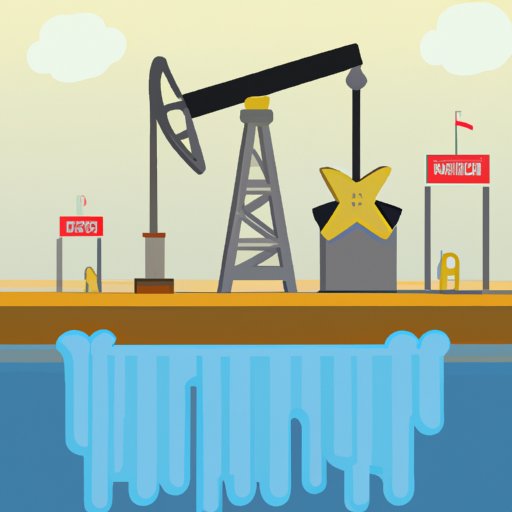Introduction
Oil wells are a critical part of the global energy system. They provide us with the fuel needed to power our cars, heat our homes, and create the products we rely on in our daily lives. But how do oil wells work? In this article, we’ll explore the process of drilling for oil and the different types of oil wells, as well as safety measures, environmental impacts, economics, and job opportunities related to the industry.
Drilling Process
The process of drilling for oil begins with prospecting. Geologists study geological data to determine where oil might be found and then use seismic surveys to pinpoint potential sites. Once a site is identified, an exploratory well is drilled. If the exploratory well produces oil or natural gas, then production wells are drilled to extract the hydrocarbons.
Drilling an oil well requires specialized equipment. A drilling rig is used to bore a hole in the ground and to lower the drill pipe, casing, and other tools down into the hole. The drill bit is connected to the end of the drill pipe and uses a rotating motion to break up the rock and advance the wellbore. As the wellbore is advanced, the drill pipe is removed and replaced with a larger diameter pipe called casing. Casing is used to reinforce the walls of the wellbore and prevent it from collapsing.
Types of Oil Wells
There are three main types of oil wells: vertical wells, horizontal wells, and directional wells. Vertical wells are the most common type of oil well and are drilled straight down into the ground. Horizontal wells are drilled at an angle and can extend for thousands of feet horizontally away from the wellhead. Directional wells are drilled at an angle and can curve or bend to reach a target.
Safety Measures
When drilling for oil, safety is of utmost importance. There are a number of regulations in place to protect workers and the environment. This includes the use of protective gear such as hard hats, steel toe boots, and flame-resistant clothing. Other safety practices include using air monitoring systems to detect hazardous gases and conducting regular inspections of equipment.
Environmental Impacts
Crude oil contains a variety of pollutants that can have negative impacts on the environment. These include volatile organic compounds (VOCs), heavy metals, and sulfur dioxide. If not properly managed, these pollutants can leach into groundwater or be released into the atmosphere. Oil spills can also occur during the drilling process, which can have devastating effects on wildlife and ecosystems.
Economics
Drilling for oil is an expensive endeavor. According to a 2019 report from the International Energy Agency, the cost of drilling an offshore exploration well can range from $20 million to $200 million. Additionally, there are ongoing costs associated with maintenance and repair of the well and its equipment.
Job Opportunities
Working in the oil industry can be a rewarding career. There are a variety of roles available, ranging from geologists and engineers to technicians and laborers. Training and certification requirements vary depending on the position, but all personnel must adhere to safety protocols and regulations.
Conclusion
In conclusion, oil wells are a vital part of the global energy system. The process of drilling for oil involves prospecting, drilling, and casing, and there are three main types of oil wells: vertical, horizontal, and directional. Safety measures, environmental impacts, economic considerations, and job opportunities should all be taken into account when exploring the oil industry.
(Note: Is this article not meeting your expectations? Do you have knowledge or insights to share? Unlock new opportunities and expand your reach by joining our authors team. Click Registration to join us and share your expertise with our readers.)
